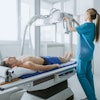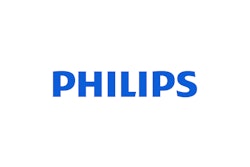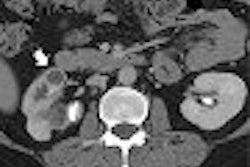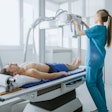
Located in the heart of the Olympic Village, where most of the athletes are housed, is a facility loaded with imaging equipment to diagnose every medical problem likely to be found among the thousands of athletes participating in the 28th Summer Olympiad over the next three weeks.
The Polyclinic covers 5,000 square meters, and includes a six-bed emergency department, a small surgery and resuscitation room, an outpatient department, a pharmacy, a small laboratory, and a large physiotherapy department that includes 12 beds, a whirlpool, a small gym, and a variety of physiotherapy machinery.
For medical imaging, the Polyclinic features two ultrasound systems, a chest x-ray machine, a fluoroscopy unit, a multislice CT scanner, and a 1-tesla MR scanner, all supplied by Philips Medical Systems of Andover, MA. Tying these together will be an integrated PACS and RIS with three viewing workstations supplied by Eastman Kodak Health Imaging of Rochester, NY, official sponsor of the 2004 Olympic Polyclinic.
And making it all useful will be a rotating crew of volunteer radiologists and radiographers, primarily from the University of Athens. Altogether, some 650 healthcare personnel have volunteered to staff the Polyclinic beginning July 30, when the first athletes began arriving in Athens in preparation for the games.
With the start of competition, the Polyclinic is expected to perform up to 140 imaging studies per day, and reach a total of more than 2,000 exams over 16 days.
"We have looked at previous data (on imaging at the Olympics)," said orthopedic surgeon and Polyclinic medical director Dr. Demetrios Pyrros. "There will be a lot of knee MRIs that are going to be performed here, that's for sure."
And if history is a guide, the demand may ultimately outrun capacity.
"I remember in Sydney (they) had so many requests for MRIs that at some point, they had to put rules (for) who could get an MRI depending on the time they were competing," said Pyrros, who visited the 2000 Polyclinic in preparation for the 2004 games.
"So if somebody has competed (already), they would get second priority from somebody who's competing in the next few days," Pyrros recalled. "For the time being, we have not set any rules regarding that, but if we have too many requests, we might need to come up with some prioritization."
Just as the Olympic venues for different sports are scattered about the region, medical facilities for the games are also spread around Athens. Kodak has installed a new direct digital radiography system, DirectView DR 9000, at KAT Hospital, one of Greece's largest trauma treatment centers.
In keeping with modern practice, many of the exam images may also be forwarded for review by specialists at other facilities. In particular, images can be transmitted from the PACS at the Polyclinic to the new PACS/RIS workstation at the Attiko University Hospital in Athens.
"So we can have an extra opinion from there, and an extra pair of eyes looking at the same images as our doctors here," Pyrros noted.
And as a backup measure, Kodak will transmit all images taken at the Polyclinic during the games to an archive facility in Milan, Italy.
New equipment is also available for the most popular service provided at the Polyclinic: free dental care for the athletes. Kodak has provided a digital dental x-ray machine, an intraoral x-ray system, a digital panoramic radiography system, and an intraoral video camera for use in the Polyclinic's four-chair dentistry section.
In a unique twist, most of the medical and dental imaging equipment at the Polyclinic will be purchased and remain on site after the games, as part of a new healthcare facility.
"It's not a temporary medical facility; it’s a permanent health structure," Pyrros noted. "It will be a legacy after the games."
"Overall, I think we are facing a big challenge ahead of us," concluded Pyrros on the Olympic healthcare task. "But we're very confident that we will be able to offer the services needed, and deliver good services for the games."
By Tracie L. Thompson
AuntMinnie.com staff writer
August 14, 2004
Related Reading
Kodak technology to be used at Olympics, July 14, 2004
Medical imaging goes for gold at Olympic Polyclinic, February 8, 2002
Copyright © 2004 AuntMinnie.com



















